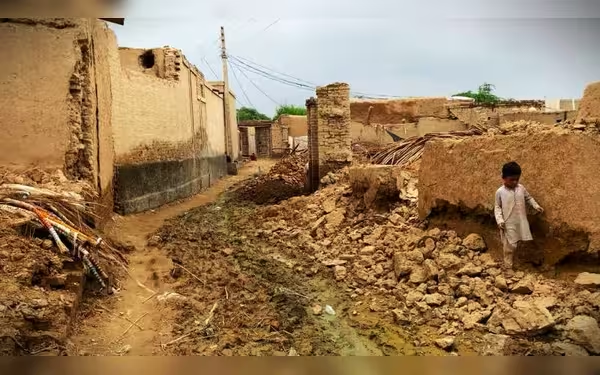Saturday, November 16, 2024 07:23 PM
KP's Children Face Climate Crisis
- Nearly half of disaster fatalities in KP are children.
- 80% of child deaths linked to climate change events.
- Urgent action needed to protect vulnerable children.
 Image Credits: thefridaytimes
Image Credits: thefridaytimesKhyber Pakhtunkhwa's children are disproportionately affected by climate change, with alarming fatalities and urgent need for protective measures.
In recent years, the province of Khyber Pakhtunkhwa (KP) has faced a relentless onslaught of climate change, manifesting in various forms such as heat waves, heavy rains, hailstorms, and devastating floods. These extreme weather events have not only caused significant damage to infrastructure but have also taken a heavy toll on the most vulnerable members of society—children. As the state grapples with the immediate consequences of these disasters, the plight of children often goes unnoticed, leaving them to bear the brunt of a crisis that threatens their lives and futures.
Data from the Provincial Disaster Management Authority (PDMA) reveals a troubling trend: over the past four years, nearly half of the 1,206 fatalities due to natural or man-made disasters in KP were children. This alarming statistic peaked in 2022, during widespread floods that wreaked havoc across the region. The PDMA's reports indicate that from 2021 to September 2024, a staggering 80% of child fatalities were linked to extreme weather events, including storms and flash floods. However, this data only scratches the surface, as it does not account for children affected by other climate-related issues such as heat waves and diseases.
Government reports highlight a significant gap in provincial-level data regarding the impact of climate change on children. This lack of information hampers efforts to address the direct and indirect consequences of the climate crisis on this vulnerable demographic. The KP Meteorological Department has noted an increase in extreme weather events, with changing patterns in rainfall and snowfall. For instance, the region experienced unusual torrential rains in March and April of this year, breaking previous records and leading to severe consequences for local communities.
As temperatures soared to record highs in May 2024, organizations like Save the Children International (SCI) reported that a third of children worldwide were exposed to extreme heat waves. In Pakistan, over 26 million school-aged children in Punjab were forced to stay home for a week due to the extreme climate, highlighting the widespread disruption caused by these environmental changes. Anwar Shahzad, a spokesperson for KP's PDMA, acknowledged that children, particularly those under five, are among the most affected by these calamities. He noted that 80% of child fatalities are linked to climate change-induced disasters, with the monsoon season being particularly deadly.
Despite the presence of early warning systems in every district, the increasing intensity and frequency of natural disasters pose significant challenges for vulnerable communities, especially in remote areas. The ongoing year has already set records for global temperatures, making it the hottest year in history. The United Nations' Inter-Governmental Panel on Climate Change (IPCC) has warned that extreme weather events will continue to escalate in frequency and intensity, particularly in South Asia.
As families in KP mourn the loss of their children to the wrath of climate change, it is crucial to recognize the urgent need for comprehensive strategies to protect the most vulnerable. Addressing the impacts of climate change on children requires a concerted effort from government agencies, non-profit organizations, and communities alike. By prioritizing the safety and well-being of children, we can work towards a future where they are not just survivors of climate disasters but also empowered advocates for a sustainable world. The time to act is now, for the sake of our children and the generations to come.













